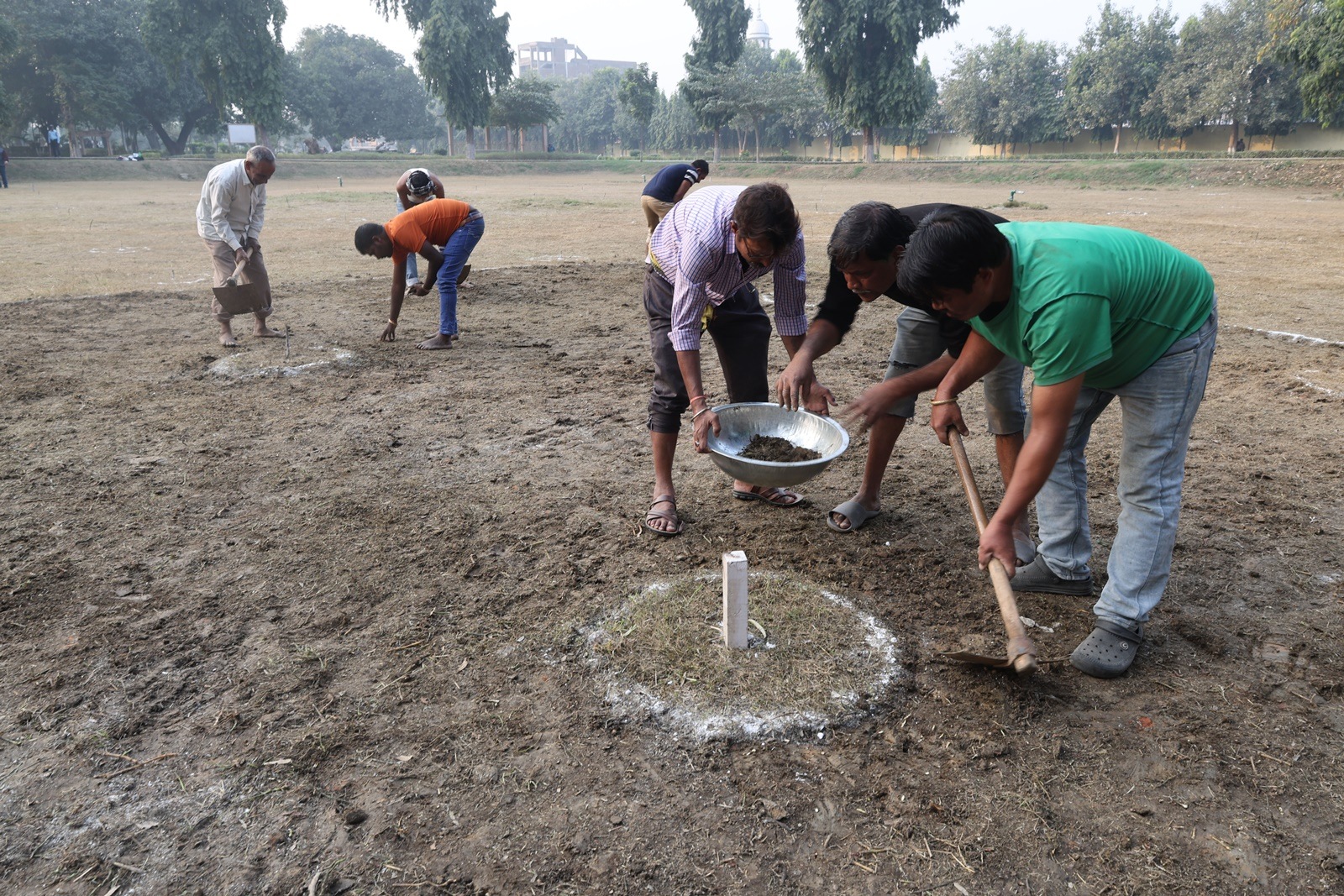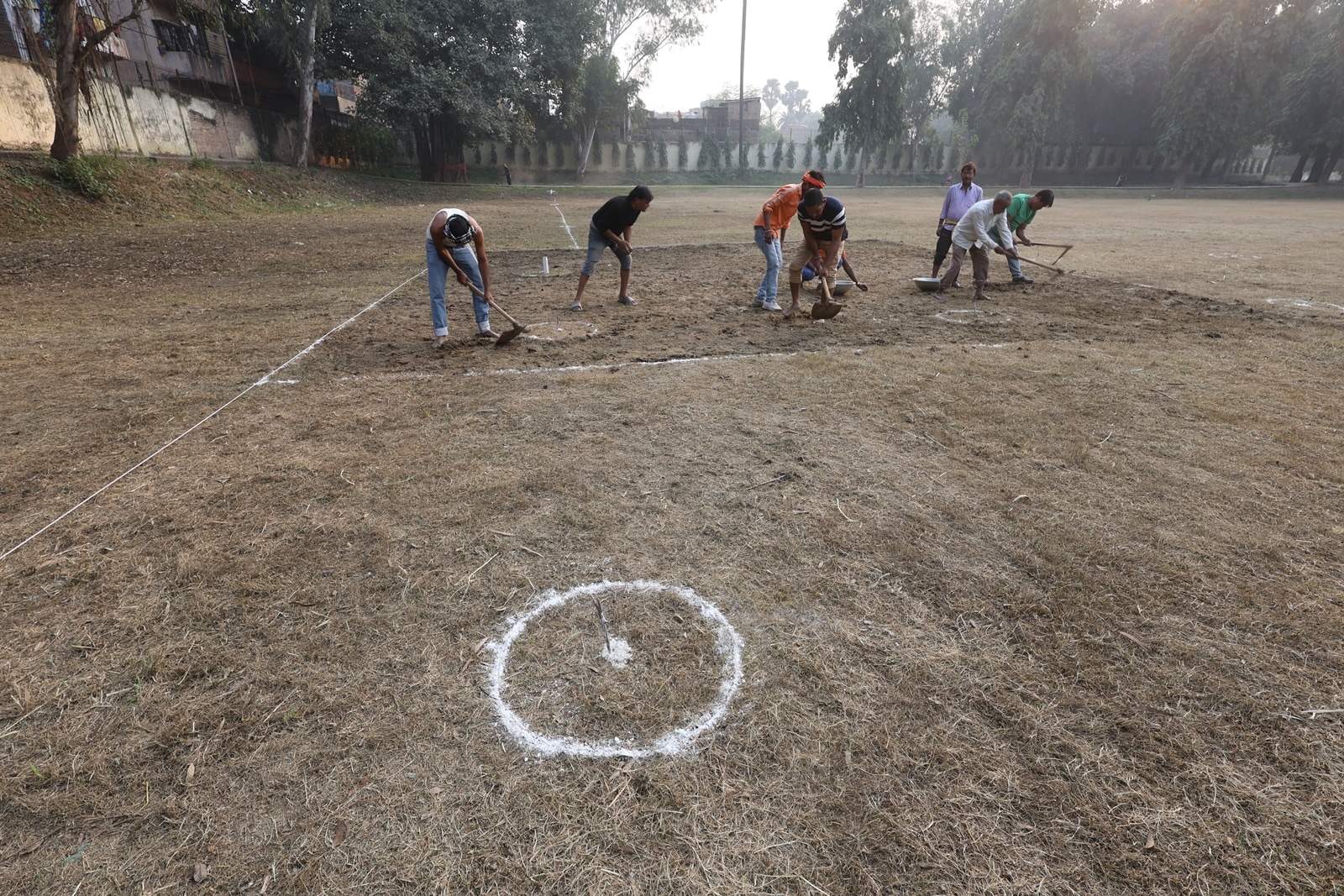Over the last few days, a rectangular patch of open ground at the Mauryan archaeological site of Kumhrar, a little over five km from the Patna railway station, has come alive with engineers and workers drawing circles on the ground with white powder. Under the green grass top, the earth hides an ancient architectural marvel – stumps and pits where 80 sandstone pillars once stood, holding up what was possibly a Buddhist assembly hall from the Mauryan era.
In 2004-2005, the Archaeological Survey of India (ASI) had covered up the area with soil after the rising water table submerged the pillar stumps. Now, 20 years later, the ASI has decided to uncover the pillars that are a key part of the evidence linking Pataliputra, the seat of the Mauryan empire, to present-day Patna.

Historians believe that it was here, in this open-air hall, with its 80 pillars standing on a wooden floor and holding up a wooden ceiling, that Emperor Ashoka, who ruled between 268 and 280 BCE, called a decisive meeting of the third Buddhist Council to unify the faction-ridden Buddhist sangha.
 Fragments of sandstone pillars on display at the Kumhrar archaeological site in Patna. (Photo/Ranjan Rahi)
Fragments of sandstone pillars on display at the Kumhrar archaeological site in Patna. (Photo/Ranjan Rahi)
On the reopening of the historical site that’s considered to be among the oldest structures in India, ASI’s Patna Circle Superintending Archaeologist Sujit Nayan, who has been leading the operation, said, “We plan to first open six-seven pillars over the next three months, during which time we will study the impact of humidity on the pillars and keep a tab on the water table with help from the Central Ground Water Board for a year. Once we get a favourable report on this, an expert committee will sit down to take a final call on reopening all 80 pillars.”
Bijoy Kumar Chaudhary, historian and former director of the Patna-based K P Jayaswal Research Institute that played a key role in excavating the pillars in the 1960s, said, “Though historians have not been conclusive about the exact time of construction of the 80-pillar hall, it surely belongs to the Mauryan period (321-185 BCE). King Ashoka is said to have called the third Buddhist Council here. Its reopening will surely evoke interest around the world and further establish and affirm the importance of Pataliputra as the seat of power of the great Mauryan empire.”
 The site at Kumhrar, before being covered up in 2004–05, displayed stumps and pits where 80 sandstone pillars once stood, supporting the Buddhist assembly hall. (Special arrangement)
The site at Kumhrar, before being covered up in 2004–05, displayed stumps and pits where 80 sandstone pillars once stood, supporting the Buddhist assembly hall. (Special arrangement)
The pillared hall, 39 metres by 32 metres, said ASI’s Nayan, was accessed by boat through a canal. “Several historians conclude that the sandstone for the pillars and wooden logs were carried via the Sone-Ganga route for construction of the hall. Brick was still not used and the hall had a wooden roof and floor.”
The ASI had excavated the 80-pillar assembly hall in two phases. The first excavation, in 1912-15, was done by American archeologist David Brainard Spooner, who found one pillar, a number of stone fragments and 80 pits, which, he concluded, were spots where the other pillars stood. The second excavation, in 1961-55, was by the K P Jayaswal Research Institute in Patna, found four more pillars.
Story continues below this ad
The biggest of these pillars, 4.6 metres long, was excavated during the first excavation by Spooner. The pillar has been kept for display near the site, along with broken fragments of other pillars. ASI sources say a few of the fragments disappeared over the years, possibly taken away by locals.
 Work has commenced on uncovering the statues. The ASI aims to unveil six to seven pillars within the next three months. (Photo/Ranjan Rahi)
Work has commenced on uncovering the statues. The ASI aims to unveil six to seven pillars within the next three months. (Photo/Ranjan Rahi)
ASI’s Nayan says the pillars, separated from each other by about 15 feet, seemed to have been of varying size, possibly because they were damaged by fire during the Indo-Greek invasion by the army of King Demetrius in 2nd Century BCE. Many historians, however, believe that it was a later-day fire, during the Huna invasion in the late 5th or early 6th century, that burnt the hall. “The excavation in 1912-1915 found evidence of thick layers of ash at the site,” said an archaeological expert.
In 2004-2005, given the rising water levels that partly submerged the pillars, an ASI expert committee decided to cover the pillar stumps with soil as part of what Nayan calls is “a standard archaeological principle of ‘if you cannot conserve it, preserve it'”. An unfortunate incident in early 2000 – when a boy drowned at the submerged site – hastened the process to cover it up.
On what prompted the reopening of the site after two decades, Nayan said, “Since the water table at Patna has receded considerably in the last two decades, and given that there has been a lot of interest about the Mauryan-era site, we decided to reopen it.” The Kumhrar site draws about 500-700 visitors every day.
Story continues below this ad
 a rectangular patch of open ground at the Mauryan archaeological site of Kumhrar, a little over five km from the Patna railway station, has come alive with engineers and workers drawing circles on the ground with white powder. (Photo/Ranjan Rahi)
a rectangular patch of open ground at the Mauryan archaeological site of Kumhrar, a little over five km from the Patna railway station, has come alive with engineers and workers drawing circles on the ground with white powder. (Photo/Ranjan Rahi)
He added that while all efforts will be made to expose the pillars for the benefit of history lovers, researchers and tourists, the ASI “will go by our rulebook and not get carried away with the buzz” surrounding the re-opening of the assembly hall.
The buzz is beginning to pick up. Praveen Mishra, a teacher who is visiting the Kumhrar site on a Tuesday morning, says, “I heard the ASI is reopening the 80-pillar hall. It’s exciting and will turn this into a bigger tourist attraction. We are proud to belong to Pataliputra.”



 Fragments of sandstone pillars on display at the Kumhrar archaeological site in Patna. (Photo/Ranjan Rahi)
Fragments of sandstone pillars on display at the Kumhrar archaeological site in Patna. (Photo/Ranjan Rahi) The site at Kumhrar, before being covered up in 2004–05, displayed stumps and pits where 80 sandstone pillars once stood, supporting the Buddhist assembly hall. (Special arrangement)
The site at Kumhrar, before being covered up in 2004–05, displayed stumps and pits where 80 sandstone pillars once stood, supporting the Buddhist assembly hall. (Special arrangement) Work has commenced on uncovering the statues. The ASI aims to unveil six to seven pillars within the next three months. (Photo/Ranjan Rahi)
Work has commenced on uncovering the statues. The ASI aims to unveil six to seven pillars within the next three months. (Photo/Ranjan Rahi) a rectangular patch of open ground at the Mauryan archaeological site of Kumhrar, a little over five km from the Patna railway station, has come alive with engineers and workers drawing circles on the ground with white powder. (Photo/Ranjan Rahi)
a rectangular patch of open ground at the Mauryan archaeological site of Kumhrar, a little over five km from the Patna railway station, has come alive with engineers and workers drawing circles on the ground with white powder. (Photo/Ranjan Rahi)





























